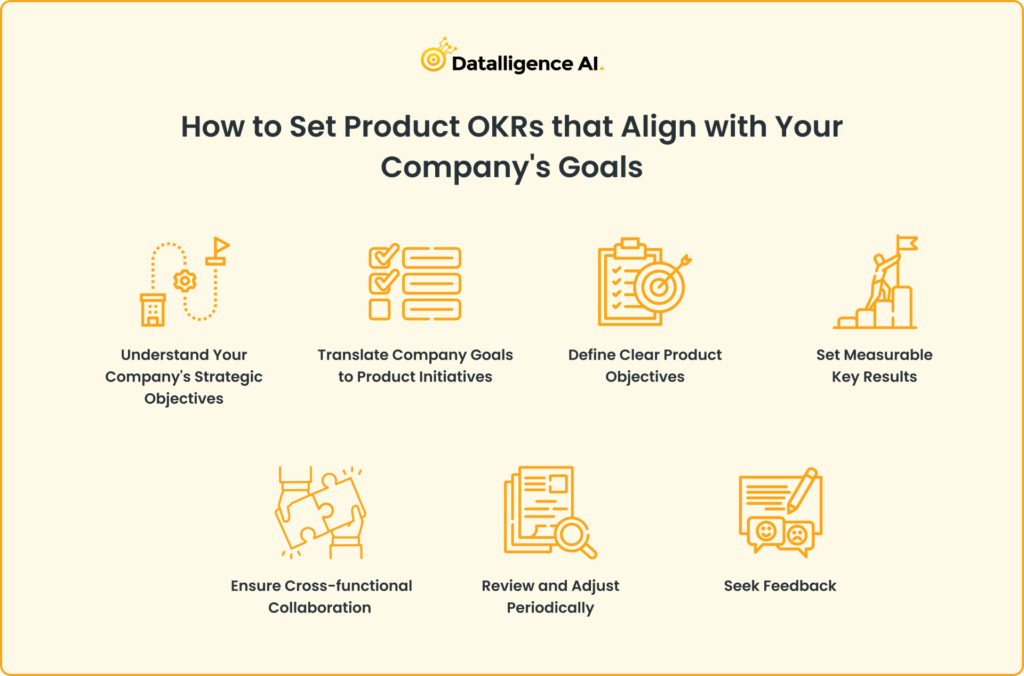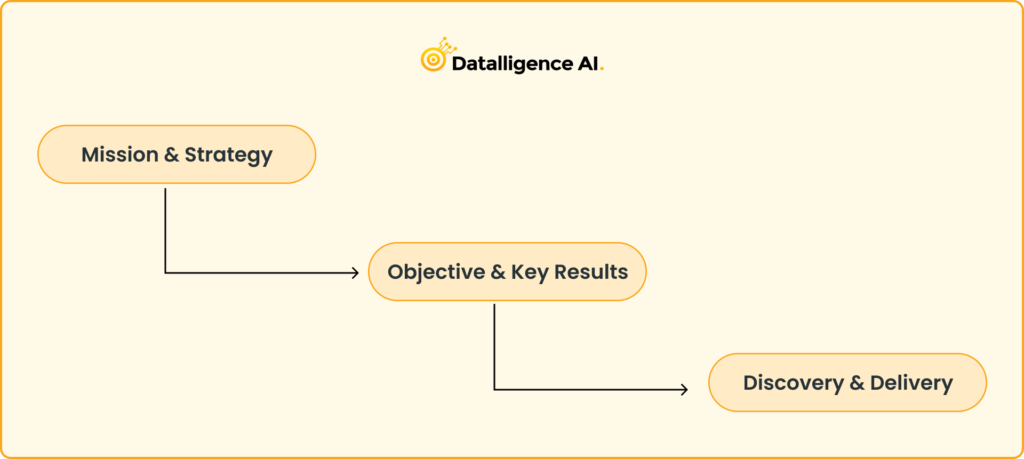In the fast-paced world of product development, keeping everyone on the same page is paramount. One of the most effective tools used by organizational goal setting to align their teams and drive productivity is OKRs. When product teams can align their OKRs with overarching company goals, it ensures that every effort, feature, and sprint contributes to the organisational goal setting
In this blog, we’ll delve into how to set product OKRs that synchronize perfectly with your company’s ambitions, ensuring that your product team OKRs are not just a checklist but a strategic roadmap.
What Are Product OKRs
At their core, product OKRs are all about aligning the product’s mission and vision with the company’s broader objectives. While the term may sound technical, it’s a straightforward principle:
- Objectives are clear, qualitative descriptions of what you want to achieve. They’re ambitious and often push the boundaries of what seems possible.
- Key Results, on the other hand, are specific, quantifiable outcomes that measure the success of the set objectives.
For instance, if an objective is to “Enhance User Engagement in the Mobile App”, a key result could be “Increase monthly active users by 25% in the next quarter”.
Product OKRs offer a strategic compass for product teams, guiding them toward impactful outcomes and ensuring alignment with organisational goal setting.
Why Are OKRs Crucial For Product Managers
Product managers are at the nexus of translating vision into actionable roadmaps. For them, the strategic clarity that OKRs offer is indispensable. Diving deeper, here are the specific reasons why OKRs are essential for product managers:
- OKRs provide a clear roadmap for prioritization amidst multiple projects.
- They ensure product strategy aligns with the company’s broader vision.
- OKRs offer quantifiable targets, fostering a data-driven approach.
- They act as a transparent tool for conveying product priorities to stakeholders.
- OKRs help in filtering out noise and centering on what truly matters.
- They encourage setting and chasing after transformative, challenging goals.
- Regular OKR reviews enable iterative improvements based on outcomes.
- Clear objectives and results inspire and align the entire product team.
- With set OKRs, resources can be strategically allocated for maximum impact.
- Through tracking OKRs, potential pitfalls can be identified and addressed promptly.
Setting Product OKRs that Align with Your Organisational Goal Setting
Setting Product OKRs that are in harmony with your company’s goals is pivotal for ensuring that product strategies and actions cater to the broader organizational objectives. Here’s a step-by-step guide on how to do it, supplemented with examples:

1. Understand Your Company’s Strategic Objectives:
Before setting any Product OKRs, it’s essential to grasp your company’s primary objectives for the upcoming period. Whether it’s expanding into new markets, increasing customer retention, or driving revenue growth, understanding these goals is crucial.
Example: If the company’s goal is to expand into the Asian market, a related product objective might be to localize the product for specific Asian languages or to develop features catering to regional needs.
2. Translate Company Goals to Product Initiatives:
Identify how your product can support or drive the company’s objectives. Break down the broader goals into product-centric strategies.
Example: For a company goal centered on customer retention, a product initiative might be enhancing user experience or adding features that have been frequently requested by existing users.
3. Define Clear Product Objectives:
Based on the identified product initiatives, define clear, actionable, and inspiring product objectives.
Example: “Enhance the mobile user experience to increase user engagement and retention.”
4. Set Measurable Key Results:
For each product objective, define quantifiable key results that would indicate the objective’s success. These should be specific and time-bound.
Example: For the objective of enhancing mobile user experience:
- Increase daily active mobile users by 20% by the end of Q2.
- Achieve a 95% positive feedback score on the new mobile interface by Q3.
- Reduce mobile app crash rate to below 0.5% by the end of Q2.
5. Ensure Cross-functional Collaboration:
Product goals often overlap with functions like marketing, sales, and customer support. Engage with these teams to ensure alignment and to set complementary OKRs.
Example: If the product’s key result is to launch a new feature, the marketing team could have a related key result centered around promoting this feature to the user base.
6. Review and Adjust Periodically:
Set regular check-ins (like quarterly reviews) to assess the progress of your Product OKRs and make necessary adjustments in response to changing circumstances or new insights.
Example: If midway through Q2, you realize that the mobile app crash rate isn’t decreasing as expected, you might need to reprioritize certain tasks or allocate additional resources to address the issue.
7. Seek Feedback:
Once your OKRs are set, gather feedback from team members and other stakeholders. This not only ensures buy-in but can also provide valuable insights that might refine your OKRs further.
Example: Developers might provide feedback about the technical feasibility of certain key results, prompting a more realistic revision.
What Are The Challenges In Setting Product OKRs
Setting Product OKRs that align with company goals can be immensely beneficial, but the process isn’t without its challenges.
Here are some of the common challenges faced by organizations:
- The difficulty arises when the company’s overarching goals are not clearly defined.
- Tendency to emphasize immediate deliverables over long-term company objectives.
- Struggling to set OKRs that are both aspirational and achievable.
- Different departments have conflicting or non-complementary objectives.
- Team reluctance to adapt to the OKR method or changes in set objectives.
- Crafting key results that lack specificity or quantifiable metrics.
- Having OKRs that outstrip available time, manpower, or budget.
- Inconsistent or unclear communication about OKRs and company alignment.
- Market shifts or global events influencing the feasibility of OKRs.
- Hesitation to set challenging OKRs due to the fear of non-achievement.
- Not reviewing or adjusting OKRs regularly, leads to potential drifts from company goals.
Product Roadmaps and OKRs—Are They the Same Thing?

No, Product OKRs and Product Roadmaps are not the same, though they complement each other in the product management realm.
Product OKRs are a goal-setting framework used to define and measure what needs to be achieved in a specific time frame. They focus on high-level objectives and the measurable results that indicate progress towards these objectives.
For example, an OKR might be set as
Objective: Enhance user engagement on our mobile app.
Key Result: Increase daily active users by 20% over the next quarter.
Learn more about Product Management OKR Examples in our Latest Blog.
On the other hand, a Product Roadmap is a strategic document that outlines the sequence of actions or features that the team plans to implement over time. It provides a visual representation of the product’s direction, detailing what features will be built, improved, or removed, and when. Using the above OKR as a context, a section of the roadmap might list:
- Introduce gamification elements to the mobile app by the end of the month.
- Launch a user feedback survey on the app interface by mid-next month.
- Revamp the app’s user onboarding experience by the end of the quarter.
In essence, while Product OKRs set the ‘what’ and ‘why’ behind a product’s goals, the Product Roadmap provides a clearer picture of ‘how’ and ‘when’ these goals will be approached or realized. OKRs might motivate a team to reach a particular outcome, but the roadmap offers the strategic path and steps to achieve that outcome.
Wrapping Up:
Setting product OKRs that align with organisational goal setting requires thoughtful effort, cross-departmental collaboration, and regular reflection. However, when done right, they can act as a powerful catalyst, driving both the product and the company towards unprecedented success.
In Conclusion, Achieving alignment and clarity in OKRs can sometimes feel overwhelming, but it doesn’t have to be. Datalligence, our OKR software, streamlines this process, offering intuitive tools and insights to help teams set, monitor, and achieve their OKRs. Whether you’re just starting with OKRs or looking to refine your approach, Datalligence ensures that your product goals are always in harmony with your company’s vision.











